Marcantonio Raimondi stands as a colossus in the history of printmaking, an artist whose technical brilliance and strategic collaborations fundamentally altered the dissemination of artistic ideas during the Italian Renaissance. Though primarily known as a reproductive engraver, his work was far more than mere mechanical copying; it was an act of translation, interpreting the grand designs of masters like Raphael into a new, accessible medium. His engravings not only popularized the High Renaissance style across Europe but also established a new standard for the art of engraving itself, influencing generations of artists and shaping the visual culture of the 16th century and beyond.
Early Life and Formation in Bologna
Marcantonio Raimondi is believed to have been born between 1470 and 1482, with most scholars leaning towards the later end of this range, possibly around 1480. His birthplace was likely Argine, near Bologna, a city with a rich artistic and intellectual heritage. His early training was under the tutelage of Francesco Raibolini, better known as Francesco Francia, a prominent Bolognese painter and, significantly, a highly skilled goldsmith. This apprenticeship in a goldsmith's workshop was crucial, as the techniques of engraving on metal for decorative purposes were directly transferable to the creation of intaglio printing plates.
Francia himself was an accomplished artist, known for his gentle Madonnas and altarpieces, which reflected the prevailing devotional sentiment of the time. Working with Francia, Raimondi would have learned the meticulous art of line engraving, the precise control of the burin, and the principles of design and composition. Bologna, at this time, was also a center for humanistic studies and had an active university, creating an environment where classical ideals and new artistic currents could flourish. It is likely that Raimondi was exposed to the works of earlier Italian engravers such as Andrea Mantegna, whose powerful, statuesque figures and classical themes had already demonstrated the potential of printmaking as a serious art form.
The Venetian Period and the Shadow of Dürer
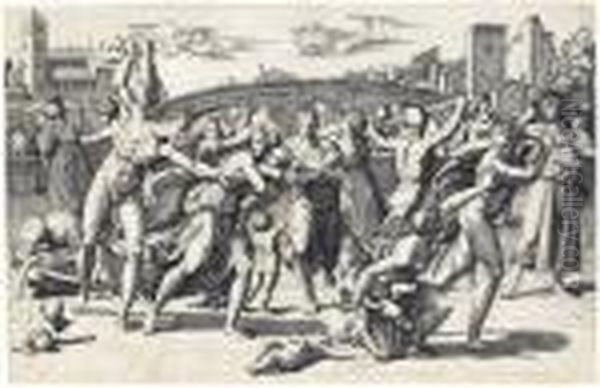
Around 1505-1506, Raimondi moved to Venice, a vibrant commercial and artistic hub. It was here that he encountered the transformative power of Northern European printmaking, particularly the works of Albrecht Dürer. Dürer's prints, both woodcuts and engravings, were circulating widely in Italy and were admired for their technical virtuosity, complex compositions, and expressive power. Raimondi was profoundly impressed, and his early independent works from this period show a clear attempt to emulate Dürer's style.
He began to produce a series of engravings that were direct copies of Dürer's woodcut series, "The Life of the Virgin." These were not just stylistic imitations but meticulous line-for-line reproductions, complete with Dürer's famous "AD" monogram. According to Giorgio Vasari, the 16th-century art historian, Dürer was so incensed by this unauthorized replication and use of his monogram – which he considered a form of trademark infringement – that he traveled to Venice to seek redress from the Venetian Senate. While the historical accuracy of Dürer's personal journey for this specific purpose is debated, the incident highlights the burgeoning awareness of authorship and the commercial value of prints. The Venetian authorities reportedly ruled that Raimondi could continue to copy Dürer's compositions but was forbidden from using the monogram. This episode, whether entirely factual or embellished by Vasari, underscores Raimondi's early ambition and his keen eye for commercially successful imagery.
Beyond Dürer, Venice exposed Raimondi to the rich colorism and atmospheric qualities of Venetian painting, exemplified by artists like Giovanni Bellini and the young Giorgione and Titian. While engraving is a linear medium, the Venetian emphasis on light and texture may have subtly influenced Raimondi's developing approach to modeling and surface. His time in Venice was formative, honing his skills and broadening his artistic horizons before his eventual move to the epicenter of the High Renaissance: Rome.
Rome and the Pivotal Partnership with Raphael
Around 1510, Marcantonio Raimondi arrived in Rome, a city then pulsating with artistic energy under the patronage of Pope Julius II and later Pope Leo X. This was the Rome of Raphael Sanzio and Michelangelo Buonarroti, who were transforming the artistic landscape with their monumental projects. It was in this charged atmosphere that Raimondi forged the most significant artistic relationship of his career, a close collaboration with Raphael.
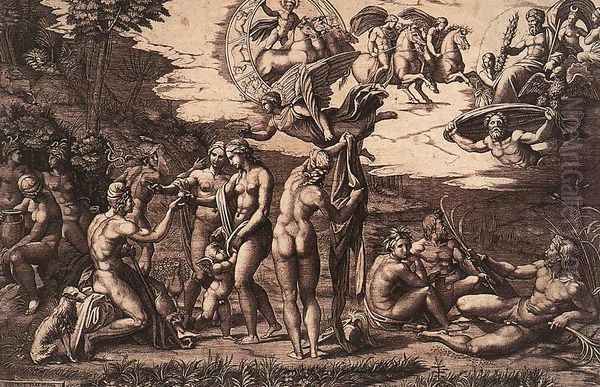
Raphael, already a celebrated painter, quickly recognized the potential of engraving to disseminate his compositions and enhance his fame. Unlike Dürer, who was his own engraver, Raphael was primarily a painter and designer. He saw in Raimondi a craftsman of exceptional skill who could translate his drawings and paintings into the linear language of engraving without losing their essential grace and power. This was not a simple master-servant relationship; it was a symbiotic partnership. Raphael would provide drawings, sometimes specifically created for engraving, and Raimondi would meticulously transfer these designs onto copper plates.
This collaboration led to the production of some of the most iconic prints of the Renaissance. Works such as The Massacre of the Innocents, based on a Raphael design, showcased Raimondi's ability to handle complex multi-figure compositions with clarity and dramatic force. The Judgment of Paris, another celebrated print after Raphael, became so influential that its composition was later famously quoted by Édouard Manet in his Le Déjeuner sur l'herbe. Other important engravings from this period include Lucretia, Quos Ego (Neptune Calming the Tempest), and numerous depictions of the Holy Family and mythological scenes.
Raimondi did not work in isolation. He established a workshop, training pupils and assistants such as Agostino Veneziano and Marco Dente da Ravenna, who helped him meet the growing demand for prints after Raphael and other artists. This "School of Raimondi" effectively became an extension of Raphael's own studio, dedicated to the production and distribution of high-quality engravings. Through this organized effort, Raphael's inventions reached a far wider audience than his paintings alone ever could, influencing artists across Italy and Northern Europe, including figures like Parmigianino and even later, Peter Paul Rubens. The collaboration was so close that some scholars believe Raphael himself may have occasionally touched up Raimondi's plates or provided very detailed preparatory drawings.
Raimondi's Engraving Technique and Evolving Style
Marcantonio Raimondi's engraving technique was characterized by its clarity, precision, and systematic approach to rendering form and texture. He primarily used the burin, a steel tool with a sharpened point, to incise lines directly into a copper plate. His lines were typically firm and deliberate, creating a sense of order and structure in his compositions.
In his early works, particularly those influenced by Dürer and Northern artists like Lucas van Leyden, Raimondi employed a dense network of lines and cross-hatching to achieve rich tonal effects and detailed surfaces. However, as he matured, especially under the influence of Raphael's classicizing style, his approach became more streamlined and harmonious. He developed a more open system of parallel hatching and swelling lines to model forms, creating a sense of volume and plasticity that was well-suited to Raphael's idealized figures.
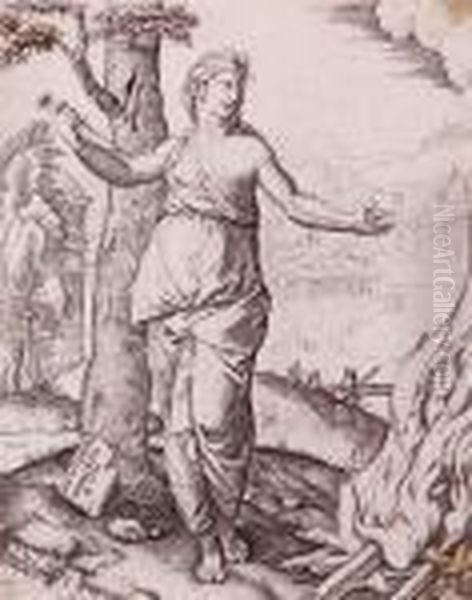
Raimondi excelled at translating the painterly qualities of Raphael's drawings – the subtle gradations of light and shadow, the graceful contours of figures, and the harmonious balance of compositions – into the inherently linear medium of engraving. He was less concerned with the highly expressive, almost agitated line work of some Northern printmakers and more focused on achieving a sense of classical calm and clarity. His figures possess a sculptural quality, and his compositions are typically well-ordered and legible.
While he also engraved works after other masters, including Michelangelo (e.g., details from the Sistine Ceiling like The Climbers, based on the Battle of Cascina cartoon) and ancient sculptures, his style remained most closely aligned with the grace and harmony of Raphael. He was not an innovator in the sense of inventing new engraving techniques, but he perfected the existing ones to an unprecedented degree, establishing a "classical" style of engraving that became the academic standard for centuries. His ability to systematically render form through controlled networks of lines provided a model for reproductive engravers for generations.
Masterpieces of Engraving: Key Works Explored
Several of Raimondi's engravings stand out as masterpieces, not only for their technical skill but also for their historical importance and influence.
The Massacre of the Innocents (c. 1511-1512): Based on a design by Raphael, this print exists in two versions, one with a fir tree in the background (a detail possibly added by Raimondi to evoke Northern prints) and one without. It is a powerful and dynamic composition, filled with dramatic action and emotional intensity. Raimondi masterfully captures the contorted bodies, the anguished expressions of the mothers, and the brutal efficiency of the soldiers. The print demonstrates his ability to manage a complex, multi-figure scene with remarkable clarity, ensuring that each element contributes to the overall narrative impact.
The Judgment of Paris (c. 1510-1520): Another engraving after a lost Raphael design, this print is celebrated for its harmonious composition and the graceful depiction of classical figures. It shows Paris awarding the golden apple to Venus, with Juno and Minerva looking on, surrounded by river gods and other mythological figures. The serene beauty and balanced arrangement of the figures are characteristic of Raphael's High Renaissance classicism. As mentioned, its enduring influence is evident in its quotation by Manet centuries later, a testament to its iconic status.
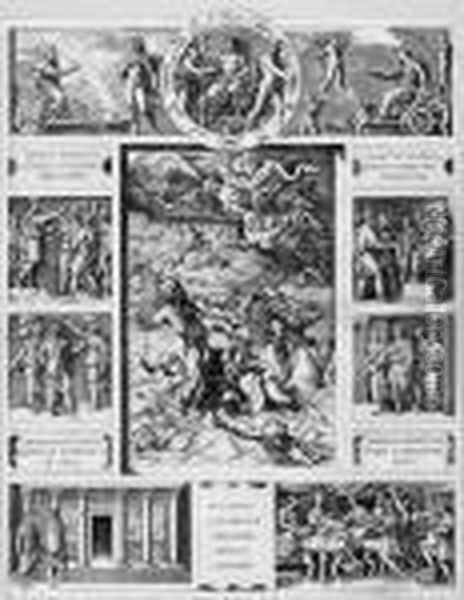
Lucretia (c. 1510-1512): This depiction of the Roman heroine Lucretia plunging a dagger into her chest is a powerful image of virtue and sacrifice. Based on a Raphael drawing, Raimondi's engraving captures the pathos of the moment with a combination of classical restraint and emotional intensity. The figure's anatomy is rendered with precision, and the drapery falls in elegant, sculptural folds.
Quos Ego (Neptune Calming the Tempest) (c. 1515-1516): This print, based on a passage from Virgil's Aeneid, shows Neptune rising from the sea to calm a storm whipped up by Aeolus at Juno's behest. The dynamic composition and the powerful rendering of the sea god and his attendants showcase Raimondi's skill in depicting mythological narratives with grandeur and energy. It is believed Raphael designed this specifically for engraving.
Adam and Eve (c. 1510-1512): While Raimondi copied Dürer's Adam and Eve, he also produced his own versions based on other designs, including those by Raphael. These prints often show a softer, more Italianate interpretation of the theme compared to Dürer's more angular and detailed Northern style. They highlight Raimondi's ability to adapt his technique to different source materials while maintaining his characteristic clarity.
These works, among many others, solidified Raimondi's reputation as the foremost engraver of his time. They were not just copies but artistic statements in their own right, valued for their beauty and technical excellence. They played a crucial role in disseminating the ideals of the High Renaissance throughout Europe, making the compositions of Raphael and other masters accessible to a wider audience of artists and collectors.
The I Modi Scandal and Its Ramifications
Despite his esteemed position, Raimondi's career was not without controversy. Around 1524, he became embroiled in a scandal that led to his imprisonment. He engraved a series of sixteen erotic images known as I Modi ("The Positions" or "The Ways"), based on designs by Giulio Romano, Raphael's principal pupil and successor. These explicit depictions of various sexual acts were then accompanied by sonnets written by the satirical poet Pietro Aretino, further amplifying their provocative nature.

The publication of I Modi caused an uproar. Pope Clement VII, who had succeeded Leo X, was outraged by the perceived obscenity of the prints. He ordered all copies to be seized and destroyed, and Marcantonio Raimondi was arrested and imprisoned. Giulio Romano, the designer, had prudently left Rome for Mantua before the scandal fully erupted, thus escaping direct papal censure. Aretino, initially also in trouble, eventually managed to secure Raimondi's release through the intervention of influential patrons, including Cardinal Ippolito de' Medici and Baccio Bandinelli, another artist whose works Raimondi had engraved.
The I Modi affair is significant for several reasons. It highlights the tension between artistic freedom and censorship, particularly in a period of increasing religious orthodoxy leading up to the Counter-Reformation. It also demonstrates the power of the printed image to provoke and to disseminate potentially subversive content. While most copies of the original I Modi were destroyed, some fragments and later copies survive, attesting to the enduring fascination with the work. The scandal undoubtedly damaged Raimondi's reputation in some circles and may have contributed to a period of financial difficulty for him. It serves as a stark reminder that even celebrated artists were not immune to the moral and political pressures of their time.
Later Career, the Sack of Rome, and Final Years
Following his release from prison, Raimondi continued to work, though the I Modi scandal had taken its toll. The artistic landscape of Rome was about to be violently disrupted. In 1527, the troops of Holy Roman Emperor Charles V mutinied and brutally sacked the city. The Sack of Rome was a catastrophic event that effectively ended the High Renaissance in the city. Artists fled, patrons were ruined, and a period of immense cultural and economic devastation ensued.
Raimondi, like many others, suffered greatly during the Sack. Vasari reports that he was forced to pay a heavy ransom to the invading soldiers and lost all his possessions. Stripped of his wealth and with Rome in chaos, he eventually made his way back to Bologna.
His activities in Bologna during his final years are less well-documented. He likely continued to produce engravings, but the vibrant artistic environment and the prestigious patronage he had enjoyed in Rome were gone. The exact date of his death is uncertain, but it is generally believed to have occurred around 1534 in Bologna. Despite the tumultuous end to his career, his impact on the art world was already firmly established.
Art Historical Significance and Enduring Legacy
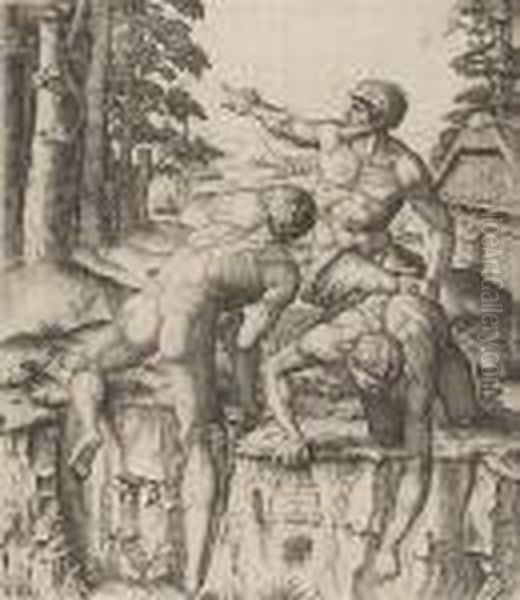
Marcantonio Raimondi's importance in art history is multifaceted. Firstly, he was a pioneer in the field of reproductive printmaking. He established a systematic and highly skilled approach to translating the works of painters and sculptors into engravings, thereby making these images accessible to an unprecedentedly wide audience. Before the advent of photography, engravings like Raimondi's were the primary means by which artistic compositions could be studied and disseminated across geographical boundaries.
Secondly, his collaboration with Raphael was a landmark in the history of artistic partnerships. It created a model for how a painter could work with an engraver to promote their designs and extend their influence. The "Raimondi school" of engravers, trained in his workshop, continued this tradition, ensuring that the High Renaissance style, particularly as defined by Raphael, became the dominant visual language for much of the 16th century. Artists across Europe, from France and the Netherlands to Spain and Germany, learned about Italian Renaissance art through these prints. Figures like the Flemish artist Lambert Lombard and the Spanish painter Gaspar Becerra were profoundly influenced by these reproductions.
Thirdly, Raimondi's technical mastery set a new standard for engraving. His clear, controlled lines and his systematic approach to modeling form became the basis for academic engraving for centuries. While later artists would explore more expressive and painterly printmaking techniques, Raimondi's classical style remained a benchmark of excellence.
However, his legacy is not without its complexities. The very nature of his work as a reproductive engraver has led some later critics, particularly in the era that prized originality above all else, to view him more as a skilled craftsman than a truly original artist. Yet, this perspective overlooks the immense creativity and artistic judgment required to translate complex paintings into the linear medium of engraving. His interpretations were not slavish copies but thoughtful translations that captured the spirit and essence of the original works.
Giorgio Vasari, in his Lives of the Most Excellent Painters, Sculptors, and Architects, dedicated a biography to Raimondi, recognizing his significance and the quality of his output, even while recounting the Dürer and I Modi controversies. This inclusion by Vasari, a contemporary and a key shaper of art historical narratives, cemented Raimondi's place in the canon of Renaissance artists.
Conclusion: An Indelible Mark on Western Art

Marcantonio Raimondi was more than just an engraver; he was a crucial conduit for the artistic currents of his time. His meticulous burin brought the monumental visions of Raphael, Michelangelo, Giulio Romano, and others into the hands of countless individuals, democratizing access to art in a way previously unimaginable. He navigated the complexities of artistic collaboration, the challenges of the burgeoning print market, and the perils of censorship, leaving behind a body of work that is both a testament to his own skill and a vital record of the High Renaissance. While the debate between "originality" and "reproduction" may continue, Raimondi's profound influence on the visual culture of Europe is undeniable. He elevated the art of engraving and, in doing so, helped to define the artistic legacy of one of the most fertile periods in Western art history. His prints continue to be studied and admired, not just as historical documents, but as works of art in their own right, bearing the indelible mark of a true master.